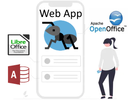
A cross-platform development framework from Microsoft called Xamarin enables programmers to create native mobile apps for iOS, Android, and Windows using a single codebase. To develop mobile applications with a native user experience and complete access to device-specific APIs and capabilities, Xamarin leverages the C# programming language and offers a collection of tools and frameworks.
Following are some of the main advantages and characteristics of utilizing Microsoft Xamarin:
Cross-platform development: Using Xamarin, developers can create code once and distribute it across a variety of platforms, thus lowering the amount of time and effort required for development. Utilizing a single codebase and Xamarin, you can create native apps for iOS, Android, and Windows.
Native user interfaces: Using Xamarin, you can design native user interfaces that mimic the style and functionality of platform-specific UI components. Xamarin.With the help of Forms' UI abstraction layer, you can create a single UI layout that is rendered in-house on any platform. Additionally, for fine-grained control and customization, Xamarin.iOS and Xamarin.Android let you create platform-specific user interfaces (UIs).
Full access to device capabilities: Xamarin gives you access to each platform's native APIs and functionalities, enabling you to make use of features like the camera, GPS, accelerometer, and more. You may take use of the extensive ecosystem of third-party components and plugins and effortlessly interface with platform-specific libraries.
Sharing of code: By using Xamarin, you can exchange networking, business logic, and data access code across several platforms, cutting down on duplication of effort and upkeep costs. Data models, services, and other elements that can be utilized by multiple platforms may be included in the same codebase while yet allowing for platform-specific UI and functionality.
Integration with Visual Studio: Xamarin strongly interacts with Microsoft Visual Studio, offering a comfortable and effective environment for developing mobile apps. Advanced testing, profiling, and debugging capabilities are included in Visual Studio, along with collaboration and version control system support.
Xamarin.: Xamarin; forms.A UI toolkit called Forms enables you to provide a single UI layout using XAML or code, and it draws the UI components natively on each platform automatically. This enables the quick construction of cross-platform user interfaces while yet preserving the option to adapt and improve for each platform as necessary.
Xamarin Test Cloud: Xamarin Test Cloud, currently called App Center Test, is a cloud-based service that enables you to test your Xamarin apps on a variety of actual devices to guarantee quality and compatibility across various platforms and device setups.
Installing the Xamarin development tools, SDKs, and Visual Studio with Xamarin workload is often the first step in using Xamarin. From there, you can make a new Xamarin project, utilize C# and the Xamarin APIs to write code, construct the user interface, and test your program on virtual or actual hardware. You may target certain platforms using Xamarin, use platform-specific APIs, and adjust the UI as necessary for each platform.
All things considered, Xamarin is a strong framework for creating cross-platform mobile apps with native functionality and performance. As a result of its robust development environment, wide range of platform compatibility, and ability to share code, it is an effective option for creating mobile applications that run on several platforms.